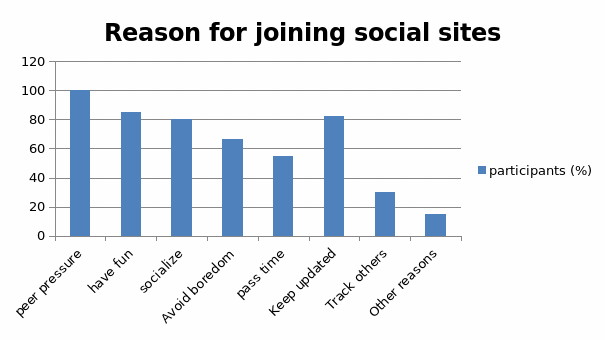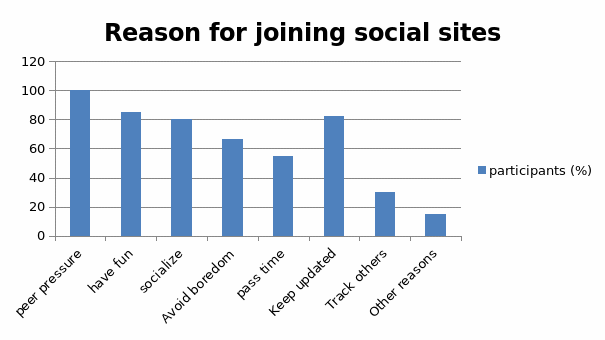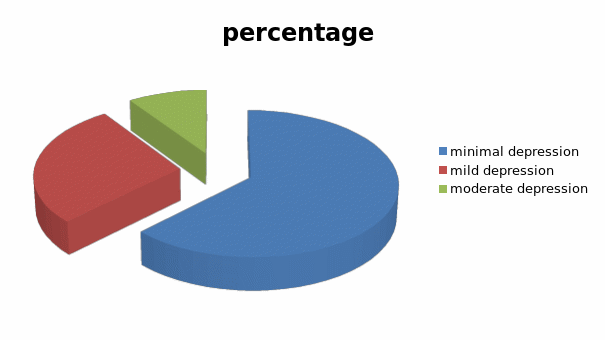Mock Data Analysis
In research on the effects of social media on depression, the results from the questionnaire can be analyzed to facilitate the answering of the research questions and interpretation to make appropriate conclusions. In the research, a sample that represented the population under study was selected for a number of reasons.
According to Veerman, Dowrick, Ayuso-Mateos, Dunn, and Barendregt (2009), sampling allows reduction in the time taken to carry out research. It also reduces the workload on the researcher while at the same time allowing room for the attainment of results that can be generalizable to the population under study (Veerman et al., 2009).
For the purpose of this study, random sampling was utilized. This ensured that the population selected was representative of the total population.
The sample consisted of 160 participants who responded to the questions in the questionnaires that were sent to them. The participants were also interviewed, with their ages being between the ages of 12-28 years. Some of the questions that they had to answer included their goals in joining social media, the number of friends that each respondent had on social media, and the feeling derived from having the number of friends.
The questions also served to evaluate whether the participants were at any time victims of cyber bullying and/or if they had participated in sexting. The evaluation of depression in the respondents was also done through the questionnaires and Beck Depression Inventory second edition (BDI-II-II), which is one of the tools that are useful in the diagnosis and evaluation of depression (Beck, Steer, Ball, & Ranieri 1996).
All the 160 people invited for the study agreed to participate by complying with the set requirements, which included being in at least one social network. Their average age was 19.6 years (SD=0.31 years). 54 (33.75%) were male, with the rest 104 (66.25%) being female.
The average age for the male participants was 20.2 years (SD=0.32), with the average age for the female participants being 19.0 years (SD= 0.31). All the 160 participants answered the question of the reason why they joined the social media.
Most of them had more than one reason of joining the social sites, with peer pressure emerging on top, with all participants (100%) ticking the option that they joined because their friends were also there.
The other reasons that featured included to have fun 136(85%), to socialize with other people of their age 128 (80%), to avoid being bored 106 (66.25%), to pass time 88 (55%), to update themselves on the latest social news and trends 132 (82.5%), and to track other individuals 48 (30%), with some 24 (15%) stating other reasons.
Figure 1: reasons for joining social sites in percentages

In responding to the number of friends that each of the respondents had on the social sites, 20 (%) had 0 to 100 friends, 48 (%) had between 100 to 500 friends 64 (%) had 500 to 1000 friends, with the rest 28 (%) having over 1000 friends on these social sites. These respondents also stated a number of feelings that they derived from having the number of friends that they stated.
Most of them stated that they were happy with having many friends, with others feeling that they were socially fulfilled. According to Mitrofan, Paul, and Spencer, teenager’s and other people participating in social network sites generally state that they have a social obligation to participate there and that not being in any social site comes with the feeling of social deficiency (2009).
Figure 2: Number of friends on social sites per respondent

The next question the respondents had to answer pertained to the experiences in relation to cyber bullying that they had in the past. Cyber bullying is currently a common problem on the social sites, affecting a significant population of individuals in these sites (Mitrofan et al., 2009).
Over half of the respondents (86 or 53.75%) had had any experience with cyber bullying. 82 of these were the victims, with 22 admitting to have cyber bullied at one time. This represented a significant problem in the population under study.
In the question of how many had participated in sexting, almost all 128 respondents responded positively as having participated in one way or the other. The analysis of these results was done manually, with qualitative approach being used in the analysis. The data on depression was also transferred and interpreted.
Figure 3: prevalence of depression

It was evident that all participants were found as positively having experienced psychological disturbance because of social media. The depression in these participants was, however, subclinical with only 10 (6.25%) students having moderate depression.
Most of the students 104 (65%) had minimal depression, with 46 (28.75%) having mild depression in the study. This shows that the prevalence of depression is high. The results have a positive correlation with the assumption made at the beginning of the mock study.
In this section, a discussion of the above results is provided. The major conclusions are also made. The study finds that most of the participants had joined social media because of having their friends on the site. This finding amounted to peer-pressure.
Peer pressure is one of the main causes of teenagers and other individuals being in social sites. The study therefore with the mock data that is provided supports the notion that most of the social sites are dependent on this influence to grow the number of their participants.
The other reasons that the participants cited indicate an underlying need to reach out to the society mainly in the participation of activities that are approved by their peers. The participants cited that the reason for being on the social sites is to have fun in the process through interaction with the other people.
This indicates a widespread acceptance of social sites in the activities of daily living. The participants felt an obligation to participate in the social activity to derive fun from it. Some of the reasons that the participants cited such as keeping track of other people were precedents of cyber bullying, with most of the participants who tracked others participating in the act of cyber bullying.
The number of friends that the participants of the mock study had in their social sites was also related to the degree of depression that they experienced. Those individuals with fewer friends were relatively more depressed as measured with the study tool.
This situation may be due to the feeling of disapproval from their peers (Pantic, Damjanovic, Todorovic, Topalovic, Bojovic-Jovic, Ristic, & Pantic, 2012, p. 92). Most of the participants viewed having many friends on social sites as being a good feeling and that they were happy when they had many of them.
They also reported that having fewer of the friends was boring. It suffices therefore to interpret that having few friends on the social sites was a predisposition to depression and that if people have few friends on the social sites; they are more likely to be depressed as compared to those who have many of the friends.
Cyber bullying is an important subject that is under discussion at many levels, with many organizations being involved in studies to estimate its prevalence and apparent harm (Lépine, & Briley, 2011). In this particular research, more than half of the participants reported experiencing or participating in cyber bullying. A significant number also reported that they had participated in cyber bullying.
The results indicate that the problem is still very prevalent among internet users. It may also be the cause of depression that the users reported experiencing. With several people reporting that they were responsible for the same, this outcome shows that ordinary people who have access to the internet are propagating the acts (Pantic et al., 2012, p. 92).
A significant proportion had also participated in sexting. This finding was also an indicator of how deeply entrenched the practice is in the social site fans (Pantic et al., 2012, p. 92).
Several ways may be used in the detection and measurement of depression in individuals. The most common of them is the use of questionnaires, with examples being the Patient Health Questionnaire (PAQ), Hospital Anxiety and Depression Scale (HADS), and Beck Depression Inventory-second edition (BDI-II) as evidenced in this study (Pantic et al., 2012, p. 92).
This tool of depression measurement is an effective one after having been used in a number of studies (Pantic et al., 2012, p. 92). Depression can be because of many factors in a society. Those with prevalent use of social sites are recognized as having a higher incidence of the same.
The results of the study above indicate that the prevalence of depression is high in individuals with usage of social sites. Some of the factors under the study such as the prevalence of cyber bullying, peer pressure, and sexting can be associated with depression in persons with usage of the social sites. The results correlate with those of other studies such as the one done by Gonzales and Hancock (2011).
Their study showed evidence of Facebook usage being related to individuals’ self-esteem. In their study, the researchers attempted to answer the question of whether concentration on an person’s silhouette as compared to “other people’s profile on the social site, the act of editing the profiles, and some of the other activities on the site may have any effect on the self-esteem of these individuals” (Gonzales,& Hancock, 2011).
With the above evidence of effects of social sites on self-esteem, it would be correct to match them with depression since low self-esteem is a factor in depression. The data above obtained from the mock study is in support of the assumption that depression is related to participation in social sites and that the age group that participated has a very high prevalence of depression.
The main limitation to the study is the relatively small sample used to carry out the research. Although this population is enough to make the valid conclusions for the study, a larger population will be more representative of the age group across the United States.
Research Questions
The formulation of research questions is important as it informs the researchers on the methodology to be applied, the expected results, and the likely conclusions (Pantic, Damjanovic, Todorovic, Topalovic, Bojovic-Jovic, Ristic, & Pantic, 2011). Research questions also ensure that the researcher sticks to the objectives of the research, thus allowing him or her chance to make the most conclusions from the research.
The research questions also allow researchers to determine the most effective data analysis for their study and the best ways of analyzing the data. In the research above, five questions were developed that required the gathering and analysis of qualitative data to answer. These will be listed below, with an explanation of the scope of each.
Why do the participants join social media sites?
Several studies have been done on the reasons why people join social sites. The studies have had important results. According to most researchers, the reason why people join the social sites may be to get some sort of satisfaction (Pantic et al., 2011). Could the reasons behind the joining of social sites be a contributor to depression?
If so, how do the reasons for joining these social sites and networks affect depression? Answering the question of why people join social sites is important in the making of conclusions in the study above.
The question will also lead to the development of other questions as to why some reasons are more prevalent in relation to others, and whether this may have any bearing on depression. A proper evaluation of the answers to the question will also be crucial in the determination of the intended results.
How many friends does each respondent have on social media?
There have been several studies trying to relate to the popularity of individuals on the social site to self-esteem that they develop. The popularity of individuals is found to have a positive correlation with the self-esteem that they develop in these studies.
One of the indicators of popularity on these social sites is the number of friends that they have. It is therefore likely that the numbers of friends per individual in a social site can correlate with the prevalence of depression. This forms a major objective of the study. The question serves to satisfy one of the objectives.
What feeling do the participants derive from having the number of friends?
Depression is a disorder in the emotional conditions of an individual. It is mainly characterized by low mood among other symptoms (de Wit, van Straten, Lamers, Cuijpers, & Penninx, 2011). The condition is therefore related to a number of feelings that people state they experience. In the diagnosis of depression, the main assessment is in the mood of the individual.
This mood is used as a reliable indicator of the individual’s state of mind. In the above study, it is important to know the feelings of the participants in their interactions with the social sites. One of the feelings is the one they feel when they have a particular amount of friends. The above question therefore serves to fulfill this purpose.
How prevalent is cyber bullying and sexting?
As stated earlier, cyber bulling is one of the contemporary problems that have occurred in the internet age. The prevalence has also been the subject of many studies. Many of the researchers report an increase in the same. Sexting is also one of the problems that have emerged with the advances in the field of telecommunication and internet. There exist few literature materials on its prevalence.
With the assumption that sexting and cyber bullying are important influential elements to the development of depression that relates to social sites, the answers to the question above will present the research with a basic indication of their prevalence in the population.
A high prevalence among social site users with depression would indicate that the two elements contribute to the depression observed in this population.
How prevalent is depression among social site users?
This inquiry forms the basis of the issue that the research attempts to investigate. The question stems from the main objective of the research, which is to evaluate the effects of social sites on depression. In the study above, the mock data shows a positive correlation between participation in social sites and the prevalence of depression.
Some researchers have also suggested the existence of depression in people using the internet and social sites. Some of the recommendations made in their research include the inference that there should be more research on the topic.
To facilitate in the answering of questions on the main effects of social sites in the causation of depression, it is important in this study to see how many of the participants have depression (Ickes, Wicklund, & Ferris, 1973).
Having a large number of these participants with depression means that the social sites can be associated with the same thing. The question serves to quantify the prevalence of depression to help in the important goal of finding a relationship between social sites and depression.
Reference List
de Wit, L., van Straten, A., Lamers, F., Cuijpers, P., & Penninx, B. (2011). Are sedentary television watching and computer use behaviors associated with anxiety and depressive disorders? Psychiatry Res, 186(2), 239-43.
Ickes, W., Wicklund, R, & Ferris, C. (1973). Objective self-awareness and self-esteem. J Exp Soc Psychol, 9(1), 202–19.
Pantic, I., Malbasa, M., Ristic, S., Turjacanin, D., Medenica, S., Paunovic, J., & Pantic, S. (2011). Screen viewing, BMI, cigarette smoking and sleep duration in Belgrade University student population: results of an observational, cross-sectional study. Rev Med Chil, 139(1), 896-901.
Beck, A., Steer, R., Ball, R., & Ranieri, W. (1996). Comparison of Beck Depression Inventories -IA and -II in psychiatric outpatients. J Pers Assess, 67(1), 588-97.
Mitrofan, O., Paul, M., & Spencer, N. (2009). Is aggression in children with behavioral and emotional difficulties associated with television viewing and video game playing? A systematic review. Child Care Health Dev, 35(1), 5-15.
Veerman, J., Dowrick, C., Ayuso-Mateos, J., Dunn, G., & Barendregt, J. (2009). Population prevalence of depression and mean Beck Depression Inventory score. Br J Psychiatry, 195(1), 516-9.
Gonzales, A., & Hancock, J. (2011). Mirror, mirror on my Facebook wall: effects of exposure to Facebook on self-esteem. Cyberpsychol Behav Soc Netw, 4(1), 79-83.
Lépine, J., & Briley, M. (2011). The increasing burden of depression. Neuropsychiatr Dis Treat, 7(1), 3-7.
Pantic, I., Damjanovic, A., Todorovic, J., Topalovic, D., Bojovic-Jovic, D., Ristic, S., & Pantic, S. (2012). Association Between Online Social Networking and Depression in High School Students: Behavioral Physiology Viewpoint. Psychiatria Danubina, 24(1), 90–93.